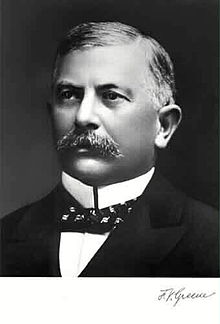Francis Vinton Greene
Francis Vinton Greene (born June 27, 1850 in Providence , Rhode Island , † May 13, 1921 in New York City ) was a senior officer in the United States Army and author of various books on military topics. He served u. a. in the Russian campaign against Turkey and in the Spanish-American War . The Greene family, from which he came, had shaped the military history of the United States for generations.
Private biography
Francis V. Greene was born on June 27, 1850 in Providence , Rhode Island , USA . Greene's family by then already held a prominent place in American military history. His father, George S. Greene, was a general during the American Civil War and made famous for his defense of Culp Hill at the Battle of Gettysburg . His older brother, Samuel D. Greene , was the officer in charge of the USS Monitor during the Battle of Hampton Roads .
He married his wife Belle Eugenie Chevallie on February 25, 1870.
Military career
Following the military tradition of his family, he attended the United States Military Academy at West Point, New York, and graduated in 1870.
He began his army service on June 15, 1870 as a second lieutenant in the US artillery before he moved to the United States Army Corps of Engineers (US Army Corps of (construction) engineers) in 1872 . He then served between 1872 and 1876 with the International Commission for the Surveying of the Northern Frontier of the United States as an astronomical assistant and land surveyor.
From 1877 to 1879 he worked for the War Department and was appointed as a military attaché to a US embassy in Saint Petersburg . In connection with this mission he entered the service of the Russian army and took part in the war between Russia and Turkey . He took part in the battles of Shipka, Plevnia, Sophia, Phillipopolis and other less significant battles. For his services he was awarded the Medials of St. Vladimir and St. Anne by the Russian Tsar.
After returning to the United States, he worked as a civil engineer for the City of Washington, DC, from 1879 to 1885 , lecturing as a professor of artillery at West Point before returning to the military on December 31, 1886.
When the Spanish-American War broke out, he joined the 7th New York Infantry and was quickly promoted to Brigadier General in the Volunteer Army. He commanded the 2nd Philippine Expeditionary Force (the Philippine Expeditionary Corps), which was later reorganized into the 2nd Division of the VIII Corps.
Greene played a vital role in the capture of the Philippine capital in the Battle of Manila . Here he first took possession of Fort San Agustín and was the first to cross the city limits of Manila with his people . He then supported Major General Wesley Merritt in the surrender negotiations with the Spaniards.
In August 1898 he was finally raised to the rank of major general before he abdicated in February 1899 and retired from military service.
Non-military career
After the war he tried his hand at different areas of responsibility. At times he was a member of the Republican National Convention . He then worked until 1904 in the New York City Police Department as a commissioner and was President of Niagara-Lockport and the Ontario Power Company.
He died in New York City on May 13, 1921, at the age of 70 .
Publications
His publications include a number of works on military campaigns such as:
- The Russian Army and its Campaigns in Turkey (“The Russian Army and its Campaign in Turkey”, two editions, 1879).
- Army Life in Russia (" Army Life in Russia ", 1881).
- The Mississippi Campaigns of the American Civil War (" The Mississippi Campaign during the American Civil War," 1882).
- Life of Nathanael Greene, Major-General in the Army of the Revolution ("The Life of Nathanael Greene , Major General in the Revolutionary Army, " 1893)
- The Revolutionary War and the Military Policy of the United States ("The American Revolutionary War and the United States Military Police," 1911).
credentials
| personal data | |
|---|---|
| SURNAME | Greene, Francis Vinton |
| BRIEF DESCRIPTION | American officer and military writer |
| DATE OF BIRTH | June 27, 1850 |
| PLACE OF BIRTH | Providence , Rhode Island |
| DATE OF DEATH | May 13, 1921 |
| Place of death | New York City , New York |
